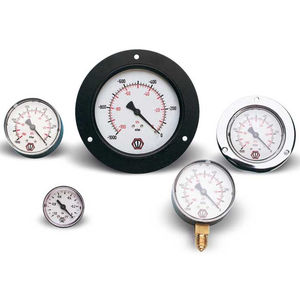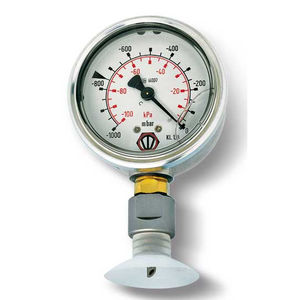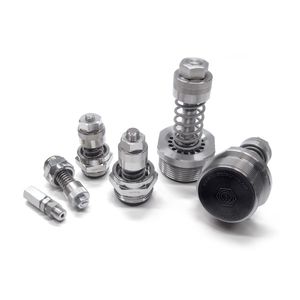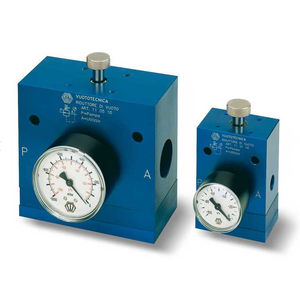
- Company
- Products
- Catalogs
- News & Trends
- Exhibitions
Diaphragm vacuum regulator 110130dial
Add to favorites
Compare this product
Characteristics
- Technology
- diaphragm
- Display
- dial
- Vacuum range
Min.: 1 mbar
(0.014503774 psi)Max.: 980 mbar
(14.213698298 psi)
Description
Vacuum regulators with pneumatic adjustment
Vacuum regulators with pneumatic adjustment differ from the previous ones for the way they adjust the vacuum level; in fact, instead of acting manually on the adjustment screw, it is necessary to act on the pneumatic cylinder compressed air supply: the higher the pressure, and the higher the vacuum level and vice versa.
Vacuum regulators are used to adjust the pre-set vacuum level and keep it constant (secondary vacuum), regardless of the pump vacuum level (primary vacuum).
Unlike the vacuum adjusting valves, regulators do not introduce air into the circuit, thus producing more gripping points with different vacuum values, from only one vacuum source.
Their operating principle is based on the contrasting action between a pneumatic cylinder with short stroke and a fluctuating piston driven by the pressure differential existing between the secondary vacuum and the atmospheric pressure.
Technical features
- Operation: membrane-piston regulator.
- Supply pressure:
--- from 0 to 3 bar (g) for regulators item 11 .. 30
--- from 0 to 5 bar (g) for regulators item 11 .. 80
- Adjustable working pressure:
--- from 800 to 1 mbar abs. for regulators item 11 .. 30
--- from 980 to 1 mbar abs. for regulators item 11 .. 80
- Capacity: from 2 to 160 m3/h
- Room temperature: from -10 to +80 °C.
- Installation position: any.
Catalogs
No catalogs are available for this product.
See all of VUOTOTECNICA‘s catalogsOther VUOTOTECNICA products
Vacuum measurement, control and adjustment instruments
Related Searches
- VUOTOTECNICA handling suction cup
- VUOTOTECNICA bellows suction cup
- VUOTOTECNICA circular suction cup
- VUOTOTECNICA flat suction cup
- Lifting vacuum suction cup
- Vacuum vacuum suction cup
- Manipulator arm with suction cup
- Plastic vacuum suction cup
- VUOTOTECNICA gripping suction cup
- Rubber vacuum suction cup
- VUOTOTECNICA oval suction cup
- VUOTOTECNICA vacuum cup holder
- Vacuum suction cup for the food industry
- VUOTOTECNICA rectangular suction cup
- VUOTOTECNICA glazing suction cup
- VUOTOTECNICA sheet metal suction cup
- Vacuum pad for the automotive industry
- VUOTOTECNICA clamping suction cup
- Suction cup for heavy-duty applications
- Vacuum regulator
*Prices are pre-tax. They exclude delivery charges and customs duties and do not include additional charges for installation or activation options. Prices are indicative only and may vary by country, with changes to the cost of raw materials and exchange rates.














